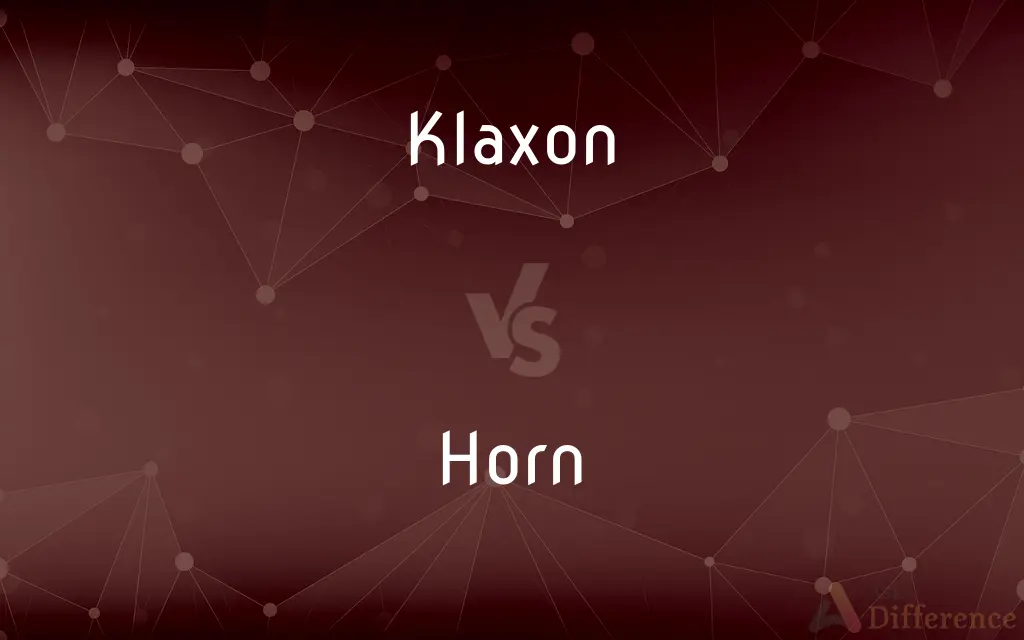Klaxon vs. Horn — What's the Difference?
By Tayyaba Rehman & Maham Liaqat — Updated on March 29, 2024
A klaxon is a specific type of electric horn that produces a loud, distinctive warning sound, often associated with alarms, whereas a horn is a broader category of sound-making devices used for signaling or warning, which can be manual or powered.

Difference Between Klaxon and Horn
Table of Contents
ADVERTISEMENT
Key Differences
A klaxon is characterized by its sharp, attention-grabbing sound, designed to alert people to danger or to signal the start of something, such as a shift change or an emergency evacuation. Its sound is often described as a loud, harsh blare, which is unmistakable and designed to be heard over other noises. On the other hand, horns encompass a wide range of sound-producing devices, including those found on vehicles, ships, and bicycles, and can produce a variety of sounds from deep and sonorous to sharp and urgent.
Klaxons are typically electrically powered and are used in specific contexts where a strong auditory signal is necessary to catch immediate attention. Horns, however, can be powered in various ways, including manually (like a bicycle horn), electrically (car horns), or by air pressure (train horns), and serve a wide range of purposes, from signaling to communication.
The term "klaxon" originally refers to a trademark for a specific type of electric horn invented in the early 20th century, known for its distinctive ahooga sound. In contrast, the concept of a horn dates back centuries and has evolved from simple animal horns and woodwind instruments to sophisticated electronic devices used in modern transportation and safety equipment.
While klaxons are often associated with emergency situations, warnings, or alarms, horns are more commonly used for indicating presence, such as when a car driver uses the horn to signal to pedestrians or other vehicles. This difference highlights the klaxon's role in safety and alert systems versus the more general communicative function of horns.
Despite these differences, both klaxons and horns play crucial roles in safety and communication, serving to alert, signal, and draw attention in various settings. The choice between a klaxon and a horn depends on the specific needs of the situation, including the type of sound required, the context of use, and the level of urgency.
ADVERTISEMENT
Comparison Chart
Sound
Loud, distinctive, often harsh and alarming.
Can vary from deep and sonorous to sharp and urgent.
Power Source
Typically electric.
Can be manual, electric, or air-powered.
Usage Context
Emergency situations, alarms, warnings.
Signaling presence, communication, safety.
Historical Origin
Early 20th century as a trademark.
Dates back centuries, evolving from animal horns and instruments.
Function
Designed to catch immediate attention.
Used for indicating presence and signaling.
Compare with Definitions
Klaxon
Characterized by its distinctive ahooga sound.
The factory's shift change was marked by the klaxon.
Horn
A device making a warning sound or signal.
He honked the car horn to alert the pedestrian.
Klaxon
An electric horn producing a loud warning sound.
The klaxon sounded, signaling the start of the evacuation.
Horn
Can be found on various vehicles, from bicycles to ships.
The ship's horn sounded as it left the harbor.
Klaxon
Often associated with specific alerts, like air raids.
The air raid klaxon could be heard throughout the city.
Horn
Used for communication in traffic.
The taxi driver used the horn to signal her arrival.
Klaxon
Integral to safety and alert systems.
Emergency services use klaxons to clear traffic.
Horn
Serves a broad range of signaling purposes.
The cyclist used his horn to navigate through the crowd.
Klaxon
Used in emergencies to alert of danger.
The submarine's klaxon blared as it dove.
Horn
Evolved from animal horns to electronic devices.
Early horns were made from actual animal horns.
Klaxon
An electric horn or warning hooter
The tug blew its klaxon three times
Horn
A hard permanent outgrowth, often curved and pointed, found in pairs on the heads of cattle, sheep, goats, giraffes, etc. and consisting of a core of bone encased in keratinized skin.
Klaxon
A loud electric alarm or horn.
Horn
The substance of which horns are composed
Powdered rhino horn
Klaxon
(intransitive) To produce a loud, siren-like wail.
Horn
A horn-shaped projection or object.
Klaxon
A kind of loud horn formerly used on motor vehicles.
Horn
A wind instrument, conical in shape or wound into a spiral, originally made from an animal horn (now typically brass) and played by lip vibration.
Klaxon
A kind of loud horn formerly used on motor vehicles
Horn
A device sounding a warning or other signal
A car horn
Horn
(of an animal) butt or gore with the horns
The bull horned him out of the way
Horn
Be unfaithful to (one's husband or wife)
All the time he was horning his wife
Horn
One of the hard, usually permanent structures projecting from the head of certain mammals, such as cattle, sheep, goats, or antelopes, consisting of a bony core covered with a sheath of keratinous material.
Horn
A hard protuberance, such as an antler or projection on the head of a giraffe or rhinoceros, that is similar to or suggestive of a horn.
Horn
The hard smooth keratinous material forming the outer covering of the horns of cattle or related animals.
Horn
A natural or synthetic substance resembling this material.
Horn
A container, such as a powder horn, made from a horn.
Horn
A horn of plenty; a cornucopia.
Horn
Either of the ends of a new moon.
Horn
The point of an anvil.
Horn
The pommel of a saddle.
Horn
An ear trumpet.
Horn
A device for projecting sound waves, as in a loudspeaker.
Horn
A hollow, metallic electromagnetic transmission antenna with a circular or rectangular cross section.
Horn
A wind instrument made of an animal horn.
Horn
A brass instrument, such as a trombone or tuba.
Horn
A French horn.
Horn
A wind instrument, such as a trumpet or saxophone, used in a jazz band.
Horn
A usually electrical signaling device that produces a loud resonant sound:an automobile horn.
Horn
Any of various noisemakers operated by blowing or by squeezing a hollow rubber ball.
Horn
(Slang)A telephone.
Horn
To join without being invited; intrude. Used with in.
Horn
(countable) A hard growth of keratin that protrudes from the top of the head of certain animals, usually paired.
Horn
Any similar real or imaginary growth or projection such as the elongated tusk of a narwhal, the eyestalk of a snail, the pointed growth on the nose of a rhinoceros, or the hornlike projection on the head of a demon or similar.
Horn
An antler.
Horn
(uncountable) The hard substance from which animals' horns are made, sometimes used by man as a material for making various objects.
An umbrella with a handle made of horn
Horn
An object whose shape resembles a horn, such as cornucopia, the point of an anvil, or a vessel for gunpowder or liquid.
Horn
The high pommel of a saddle; also, either of the projections on a lady's saddle for supporting the leg.
Horn
(architectural element) The Ionic volute.
Horn
(nautical) The outer end of a crosstree; also, one of the projections forming the jaws of a gaff, boom, etc.
Horn
(carpentry) A curved projection on the fore part of a plane.
Horn
One of the projections at the four corners of the Jewish altar of burnt offering.
Horn
(countable) Any of several musical wind instruments.
Horn
An instrument resembling a musical horn and used to signal others.
Hunting horn
Horn
A loud alarm, especially one on a motor vehicle.
Horn
A sound signaling the expiration of time.
The shot was after the horn and therefore did not count.
Horn
(countable) A conical device used to direct waves.
Antenna horn
Loudspeaker horn
Horn
Generally, any brass wind instrument.
Horn
A telephone.
Get him on the horn so that we can have a discussion about this.
Horn
An erection of the penis.
Horn
A peninsula or crescent-shaped tract of land.
To navigate around the horn
Horn
(countable) A diacritical mark that may be attached to the top right corner of the letters o and u when writing in Vietnamese, thus forming ơ and ư.
Horn
(botany) An incurved, tapering and pointed appendage found in the flowers of the milkweed (Asclepias).
Horn
(military) In naval mine warfare, a projection from the mine shell of some contact mines which, when broken or bent by contact, causes the mine to fire.
Horn
To assault with the horns.
Horn
(transitive) To furnish with horns.
Horn
To cuckold.
Horn
A hard, projecting, and usually pointed organ, growing upon the heads of certain animals, esp. of the ruminants, as cattle, goats, and the like. The hollow horns of the Ox family consist externally of true horn, and are never shed.
Horn
The antler of a deer, which is of bone throughout, and annually shed and renewed.
Horn
Any natural projection or excrescence from an animal, resembling or thought to resemble a horn in substance or form;
Horn
An incurved, tapering and pointed appendage found in the flowers of the milkweed (Asclepias).
Horn
Something made of a horn, or in resemblance of a horn
Horn
One of the curved ends of a crescent; esp., an extremity or cusp of the moon when crescent-shaped.
The moonWears a wan circle round her blunted horns.
Horn
The curving extremity of the wing of an army or of a squadron drawn up in a crescentlike form.
Sharpening in mooned hornsTheir phalanx.
Horn
The tough, fibrous material of which true horns are composed, being, in the Ox family, chiefly albuminous, with some phosphate of lime; also, any similar substance, as that which forms the hoof crust of horses, sheep, and cattle; as, a spoon of horn.
Horn
A symbol of strength, power, glory, exaltation, or pride.
The Lord is . . . the horn of my salvation.
Horn
An emblem of a cuckold; - used chiefly in the plural.
Horn
The telephone; as, on the horn.
Horn
A body of water shaped like a horn; as, the Golden Horn in Istanbul.
Horn
To furnish with horns; to give the shape of a horn to.
Horn
To cause to wear horns; to cuckold.
Horn
A noisemaker (as at parties or games) that makes a loud noise when you blow through it
Horn
One of the bony outgrowths on the heads of certain ungulates
Horn
A noise made by the driver of an automobile to give warning;
Horn
A high pommel of a Western saddle (usually metal covered with leather)
Horn
A brass musical instrument with a brilliant tone; has a narrow tube and a flared bell and is played by means of valves
Horn
Any outgrowth from the head of an organism that resembles a horn
Horn
The material (mostly keratin) that covers the horns of ungulates and forms hooves and claws and nails
Horn
An alarm device that makes a loud warning sound
Horn
A brass musical instrument consisting of a conical tube that is coiled into a spiral and played by means of valves
Horn
A device on an automobile for making a warning noise
Horn
Stab or pierce with a horn or tusk;
The rhino horned the explorer
Common Curiosities
What is a klaxon?
A klaxon is an electric horn known for its loud, distinctive warning sound, often used in emergency situations.
How are horns powered?
Horns can be powered manually, electrically, or by air pressure, depending on their design and purpose.
What distinguishes a klaxon from other horns?
The klaxon's distinctive, harsh sound and its primary use in alerting to danger or emergencies distinguish it from other horns.
Can any horn be considered a klaxon?
Not all horns are klaxons; klaxons are specifically designed for producing a loud warning sound, typically in emergencies.
What role do horns play in safety?
Horns play a crucial role in safety by signaling presence and alerting others to potential hazards.
How did the klaxon get its name?
"Klaxon" comes from a trademark for a specific type of electric horn patented in the early 20th century, derived from the Greek word "klazō," meaning "to shout."
Are klaxons used in any specific industries?
Klaxons are widely used in industries where emergency alert systems are essential, such as maritime, manufacturing, and emergency services.
What are common uses for horns?
Horns are used for signaling presence, communication, and safety across various vehicles and situations.
How do people react to the sound of a klaxon?
The sound of a klaxon is designed to prompt an immediate reaction, often alertness or urgency, due to its association with emergencies.
Is the klaxon still used today?
Yes, klaxons are still used today, especially in safety and emergency alert systems.
Why are klaxons important in emergency situations?
Klaxons quickly grab attention with their loud, distinctive sound, making them vital for immediate warning and evacuation signals.
What are the legal regulations around horn use?
Legal regulations around horn use vary by location but generally include restrictions on unnecessary use to prevent noise pollution.
Can the sound of a horn vary?
Yes, the sound of a horn can vary greatly, from deep and resonant to sharp and piercing, depending on its design and purpose.
How has the use of klaxons and horns evolved?
The use of klaxons and horns has evolved with technology, from manual and mechanical to electronic, enhancing their effectiveness in communication and safety.
What historical significance do horns have?
Horns have a long history, evolving from simple animal horns used for signaling to sophisticated electronic devices in modern transportation and safety.
Share Your Discovery

Previous Comparison
Harpsichord vs. Harp
Next Comparison
Rebound vs. BounceAuthor Spotlight
Written by
Tayyaba RehmanTayyaba Rehman is a distinguished writer, currently serving as a primary contributor to askdifference.com. As a researcher in semantics and etymology, Tayyaba's passion for the complexity of languages and their distinctions has found a perfect home on the platform. Tayyaba delves into the intricacies of language, distinguishing between commonly confused words and phrases, thereby providing clarity for readers worldwide.
Co-written by
Maham Liaqat













































